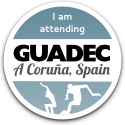I’m looking forward to this year’s GUADEC. I missed the one last year, so it’s going to be great to be back. As usual, there are lots of people who I’m looking forward to seeing in person, including both established and new contributors.
GUADEC 2012 could be an important one for GNOME, I think. These are interesting times for our project. GNOME 3 is only 16 months old. This year’s conference is, somewhat remarkably, GNOME’s first since 3.0 was released in April 2011 (what with last year’s conference being a Desktop Summit).
GNOME has come a long way since the initial release of GNOME 3. We’ve worked hard to refine and extend our new user experience. I don’t think it’s an exaggeration to say that almost every part of GNOME 3 has been improved. On top of that, we’ve also introduced a stream of new features that complement what we released for 3.0.
The most important development since the release of GNOME 3.0, in my opinion, is that we have started to articulate a new vision for GNOME applications, and we have initiated a range of application development efforts as a part of that. We have new applications in the shape of Documents, Boxes, Contacts, Clocks and soon, hopefully, Calendar. We also have redesigned applications like Epiphany (now called Web) and Nautilus (now Files). This effort to articulate a new vision for GNOME applications represents nothing less than the future of our project.
But we live in competitive times, and the GNOME 3 effort is an ongoing one. Thinking about where GNOME is right now, my view is that the project faces a number of crucial challenges which it needs to take on if it is going to succeed.
First, we need to evolve how we work in order to ensure the quality of the GNOME 3 user experience. Quite simply, we have to raise the bar. GNOME has to ensure that new features are successfully executed, and we have to maintain a high level of quality across our entire user experience.
Second, I think that we need to establish a strong vision for GNOME 3. All too often, we see the GNOME UX as a collection of parts, rather than as a consistent and integrated experience. This needs to change – to create a high-quality user experience, we have to think of GNOME 3 as a product. That requires a unified design for our core applications and a complete experience that has no missing pieces.
Third and finally, a big challenge for GNOME right now is how we talk about our project. We need to articulate an effective and powerful value proposition for GNOME. My personal view is that GNOME has an incredibly compelling story to tell, a story that can motivate and direct our efforts as contributors, as well as those of our partners and supporters. We need to tell that story in a concise and arresting way, so that people can easily understand and relate to our goals, and so that we can effectively direct our activities as a project.
In my mind, these are the critical areas which we need to address if GNOME is going to succeed. (There’s actually one more that I would include in that list – that’s something that me, Jon and Jimmac will be talking about in our GUADEC presentation.) The good news is that this year’s GUADEC shows signs that the project is rising up to these challenges. We have a UX Hackfest taking place, talks about how the UX relates to the OS, about testing, and about the role of design in GNOME. We also have BoFs planned that will discuss new feature initiatives and the future of GNOME. Together, these events promise to help us come up with solutions to the challenges we face.
GUADEC is our opportunity as a community to get together and talk about the issues that matter. Let’s make this one count.

Way to go on all of the great renaming! Moving from an obscure, intimidating name to simpler, familiar name is an easy UX victory. Now just rename “GNOME.”